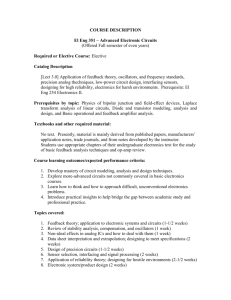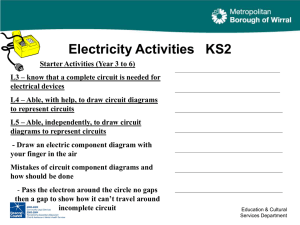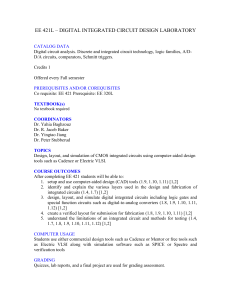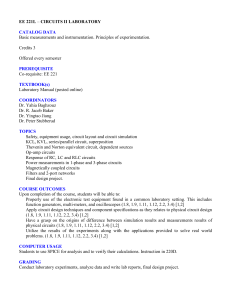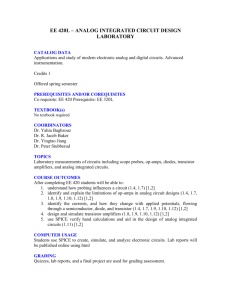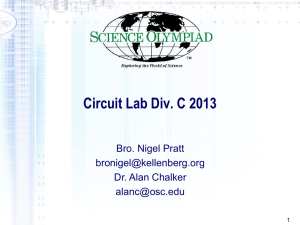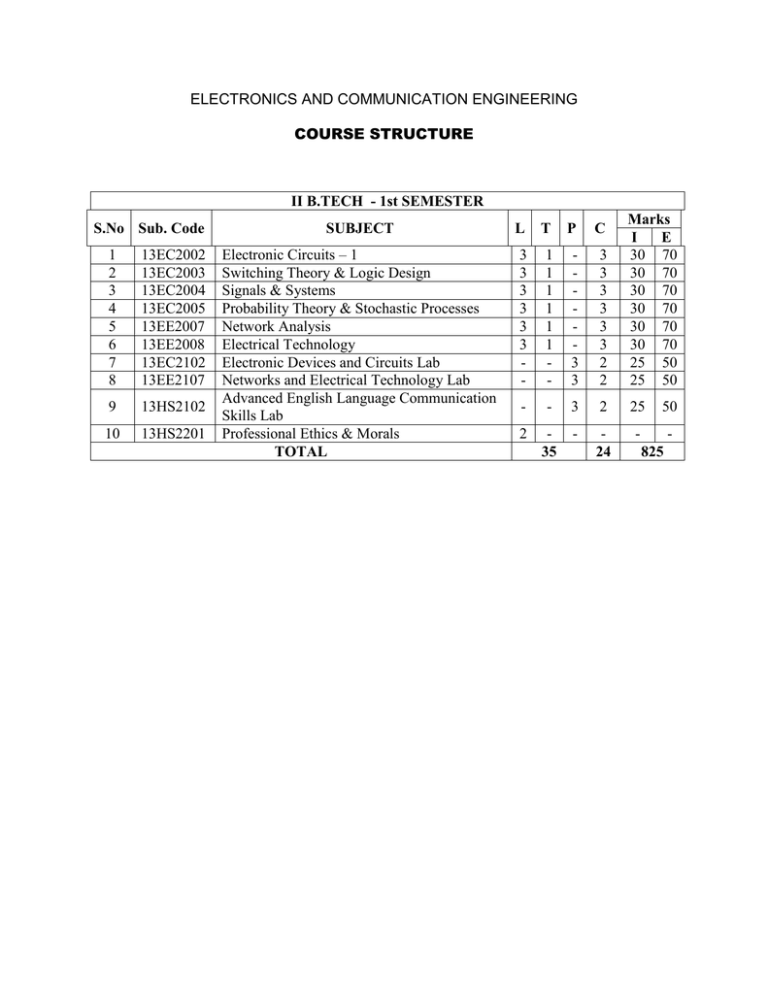
ELECTRONICS AND COMMUNICATION ENGINEERING
COURSE STRUCTURE
II B.TECH - 1st SEMESTER
S.No Sub. Code
1
2
3
4
5
6
7
8
13EC2002
13EC2003
13EC2004
13EC2005
13EE2007
13EE2008
13EC2102
13EE2107
9
13HS2102
10
13HS2201
SUBJECT
L
T
P
C
Electronic Circuits – 1
Switching Theory & Logic Design
Signals & Systems
Probability Theory & Stochastic Processes
Network Analysis
Electrical Technology
Electronic Devices and Circuits Lab
Networks and Electrical Technology Lab
Advanced English Language Communication
Skills Lab
Professional Ethics & Morals
TOTAL
3
3
3
3
3
3
-
1
1
1
1
1
1
-
3
3
3
3
3
3
3
3
2
2
Marks
I
E
30 70
30 70
30 70
30 70
30 70
30 70
25 50
25 50
-
-
3
2
25
50
2
35
-
24
-
825
Aditya Institute of Technology and Management (Autonomous), Tekkali
II Year B.Tech (Electronics and Communication Engineering) – 1st Sem.
ELECTRONIC CIRCUITS – I
Subject Code: 13EC2002
: 3 Internal Marks: 30
70
Credits
External Marks :
Objective
•
To make the student understand the basic principles and abstractions that are used to
analyze and design electronic circuits (Filters, regulators, amplifiers, single stage
amplifiers) at low and high frequency conditions.
Outcome
•
At the end of the course the students are able to analyze and design electronic circuits according
to given specifications.
Syllabus
Unit – I
Filters and Regulators: Harmonic components in a rectifier circuit, Inductor filter, Capacitor
filter, L – section filter, - section filter, Multiple L – section and - section filters. Comparison of
filter circuits, Simple regulator circuits using Zener diode.
Unit – II
Transistor Biasing and Stabilization: Operating point, basic stability; collector to base bias,
self bias amplifiers. Stabilization against variations in VBE and β for the self bias circuit.
Stabilization factors (S, S', S'’). Bias compensation, thermistor and sensistor compensation,
compensation against variation in VBE, Ico. Thermal runaway and Thermal stability.
FET: As voltage variable resistor and biasing.
Unit – III
Low frequency analysis of Transistor: Two port devices and the hybrid model, transistor
hybrid model, determination of h-parameters from characteristics, measurement of h-parameters,
conversion formulas for the parameters of three transistor configurations, analysis of transistor
amplifier circuits using h- parameters, comparison of transistor amplifier configurations.
FET: Small signal model and analysis.
Unit – IV
Single stage Amplifiers: Simplified common emitter hybrid model, simplified calculations for
common collector configuration and common base amplifier, common emitter amplifier with
emitter resistance, Emitter follower, Miller’s theorem and dual of Miller’s theorem.
FET: Common source and common drain amplifiers.
Unit – V
High frequency Analysis: Hybrid- π common emitter transistor model, hybrid π conductance,
hybrid π capacitance, validity of hybrid π model, variation of hybrid parameters, CE short circuit
gain, current gain with resistive load, single stage CE transistor amplifier response, gain
bandwidth product, Emitter follower at high frequencies.
FET: Common source and common drain amplifiers.
Text Books:
•
•
Integrated Electronics – J. Millman and C.C. Halkias, Mc Graw-Hill, 1972.
Electronic Devices and Circuits – Salivahanan, N.Suresh Kumar, A. Vallavaraj, Tata
McGraw Hill, 2/e.
Reference Books:
•
•
Electronic Devices and Circuits Theory – Robert L. Boylestad and Louis Nashelsky,
Pearson/Prentice Hall, 2006, 9/e.
Micro Electronic Circuits – Sedra A.S. and K.C. Smith, Oxford University Press, 5/e.
Aditya Institute of Technology and Management (Autonomous), Tekkali
II Year B.Tech (Electronics and Communication Engineering) – 1st Sem.
SWITCHING THEORY AND LOGIC DESIGN
Subject Code: 13EC2003
3 Internal Marks: 30
70
Credits :
External Marks :
Objectives:
With this course, students will learn different number systems and their applications , Boolean
Algebra, Minimization of Switching functions, Karnaugh map method, Tabulation method,
Logic gates, Combinational Logic circuits , sequential Logic circuits and to identify suitable
designing procedures for the given problems.
Outcomes:
After Completing this course student should be able to know how to Minimize Switching
functions and able to know how to design combinational logic circuits, sequential logic circuits
and memories.
UNIT I:
Review of Number systems:
Number systems Base conversion methods, complements of numbers, r’s, r-1’s compliment
subtraction.BCD, Excess-3, Alphanumeric code, self complement codes, 2421, gray code, error
detection & correction codes, Parity checking codes, Hamming codes.
UNIT II:
Logic operations:
Logic Gates, Boolean theorems, complements and dual of logic expressions, standard SOP &
standard POS. Minimization of logic functions using theorems. Multi level NAND – NAND,
NOR-NOR Realizations.
UNIT III :
Minimization of switching functions:
Minimization of switching functions using K-Map up to 5-variables, code converters and binary
multiplier using K-Map, Tabular minimization.
UNIT IV:
Combinational logic circuits:
Design of Half adder, full adder, half subtractor, full subtractor, applications of full adders, 4-bit
binary adder, 4-bit binary subtractor, adder-subtractor circuit, BCD adder circuit, Excess3 adder
circuit, look-a-head adder circuit.
Design of decoder, Encoder, multiplexer, demultiplexer, priority encoder, comparator, seven
segment display.
UNIT V:
Sequential logic circuits:
Classification of sequential circuits, flip-flops with truth tables and excitation tables. Conversion
of flip-flop to flip-flop.
Design of ripple counters, synchronous counters, Johnson counters, ring counters.
Design of Buffer register, control buffer register, shift register, bi-directional shift register,
universal shift register.
TEXTBOOKS:
• Digital design by Mano 2nd edition PHI.
• Fundamentals of Digital Circuits by Ananda Kumar, EEE Editiion.
• Modern Digital Electronics by RP Jain, TMH.
Reference Books:
1. Switching and Finite automata theory, 2nd Edition, Zvi Kohavi, Tata Mcgraw – Hill, 1978.
2. Micro electronics by Millman MH edition.
3. Fundamentals of Logic Design by Charles H.Roth Jr, Jaico Publishers.
Aditya Institute of Technology and Management (Autonomous), Tekkali
II Year B.Tech (Electronics and Communication Engineering) – 1st Sem.
SIGNALS AND SYSTEMS
Subject Code: 13EC2004
3 Internal Marks: 30
70
Credits :
External Marks :
Objective
The course is designed to provide:
• Fundamental concepts in time and frequency domain representation.
• Understanding the classification of signals and systems.
• Need of sampling, convolution and correlation concepts and its applications in signal
processing.
• Importance of Laplace transforms in solving differential equations. Brief knowledge on
Z- Transform.
Outcome
At the end of the course the student will be able to:
• Analyze both signals and systems in time and frequency domain, and can develop
applications like noise removal by using convolution and correlation concepts.
• Understand need of sampling.
Syllabus
Unit – I
Signal Analysis: Introduction to signals and systems, classification of signals and systems,
analogy between vectors and signals, orthogonal signal space, signal approximation using
orthogonal functions, mean square error, closed or complete set of orthogonal functions,
orthogonality in complex functions, exponential and sinusoidal signals, properties of elementary
signals.
Unit – II
Fourier Series: Representation of Fourier series, continuous time periodic signals, properties of
Fourier series, Dirichlet’s conditions, trigonometric and exponential Fourier series, Complex
Fourier spectrum.
Fourier Transform: Deriving Fourier transform from Fourier series, Fourier transform of
arbitrary signals and standard signals, properties of Fourier transforms, Fourier transform of
periodic signals.
Unit – III
Continuous Time LTI systems: Representation of continuous time signals in terms of impulses,
Linear time variant and invariant systems, unit impulse response and the convolution integral
representations of LTI system, transfer function of a LTI system. Filter characteristics of linear
systems. Distortion less transmission through a system, signal bandwidth, system bandwidth,
ideal LPF, HPF and BPF characteristics, causality and Poly-Wiener criterion for physical
realization.
Unit – IV
Convolution and Correlation of Signals: Concept of convolution and correlation in time
domain and frequency domain, cross correlation and auto correlation, energy and power density
spectrum, properties of correlation and related problems.
Sampling of Signals: Sampling theorem, Impulse sampling, Natural and Flat top sampling,
Reconstruction of signal from its samples, effect of under sampling – Aliasing.
Unit – V
Laplace Transform: Review of Laplace transforms, Laplace Transforms of typical signals,
properties of LT, relation between LT and FT of a signal. Region of convergence (ROC) and
constraints on ROC. Inverse Laplace transforms.
Z – Transform: Introduction to Z - transform.
Text Books:
•
•
Signals, Systems and Communications – B.P. Lathi, BS Publications, 2003.
Signals and Systems – A.V. Oppenheim, A.S. Willsky and S.H. Nawab, PHI, 2/e.
Reference Books:
•
•
Signals & Systems – Simon Haykin and Van Veen,Wiley, 2/e.
Fundamentals of Signals and Systems – Michel J. Robert, MGH International Edition, 2008.
Aditya Institute of Technology and Management (Autonomous), Tekkali
II Year B.Tech (Electronics and Communication Engineering) – 1st Sem.
PROBABILITY THEORY AND STOCHASTIC PROCESSES
Subject Code: 13EC2005
3 Internal Marks: 30
70
Objective
Credits :
External Marks :
•
This course develops the mathematical theory of probability, random variables and
random processes.
•
To teach the basic theoretical concepts and techniques for solving problems that arises in
practice.
Outcome
•
At the end of this course, the students will have an appreciation for the power of
stochastic processes and its range of applications and be able to formulate and solve
problems which involve setting up stochastic models.
Syllabus
Unit – I
Probability: Probability introduced through Sets and Relative Frequency: Experiments and
Sample Spaces, Discrete and Continuous Sample Spaces, Events, Probability Definitions and
Axioms, Mathematical Model of Experiments, Probability as a Relative Frequency, Joint
Probability, Conditional Probability, Total Probability, Bayes’ Theorem and Independent Events.
Unit – II
Operations on one random variable: Definition of random variable, expected value of random
variable, function of random variable, monotonic and non – monotonic transformations of
continuous random variable, conditions for a function to be a random variable. Classification and
properties of random variables. Distribution and Density functions.
Examples of density functions: Binomial, Poisson, Uniform, Gaussian, Exponential, Rayleigh
function.
Unit – III
Multiple random variable: Vector random variables, joint distribution function, properties of
joint distribution, marginal distribution functions, conditional distribution and density –
statistical independence, sum of two random variables, sum of several random variables, central
limit theorem, equal and unequal distributions.
Operations on multiple random variables: Expected value of a function of random variables,
joint moments about the origin, joint central moments, joint characteristic functions.
Unit – IV
Joint Gaussian Random Variables: Two random variables case, N random variable case,
properties, transformations of multiple random variables and linear transformations of Gaussian
random variables.
Random process: The random process concept, concept of stationarity and statistical
independence. First – order, second – order, wide – sense and strict – sense stationarity. Time
average and Ergodicity and mean – Ergodic Processes. Autocorrelation and its properties,
Covariance Functions, Gaussian Random Processes, Poisson Random Process.
Unit – V
Power Spectrum: Properties, relationship between power spectrum and autocorrelation
function, cross – power density spectrum, properties, relationship between cross – power density
spectrum and Cross – Correlation Function.
Linear Systems with Random Inputs: Random signal response of linear Systems (convolution,
mean, mean – squared, autocorrelation and cross – correlation), spectral characteristics of system
response (power density), band pass, band-limited and narrowband processes.
Modeling of noise sources: Resistive (thermal) noise structure, arbitrary noise sources, effective
noise temperature, average noise figure and average noise figure of cascaded networks.
Text Books:
•
•
Probability, Random Variables & Random Signal Principles - Peyton Z. Peebles, TMH,
2001, 4/e.
Probability, Random Variables and Stochastic Processes – Athanasios Papoulis and S.
Unnikrishna Pillai, PHI, 2002, 4/e.
Reference Books:
•
•
Probability,Stastistics and Random Processes – K.Murugesan and P.Gurusamy, Anuradha
Publications.
Probability Methods of Signal and System Analysis - George R. Cooper, Clave D. MC
Gillem, Oxford, 1999, 3/e.
Aditya Institute of Technology and Management (Autonomous), Tekkali
II Year B.Tech (Electronics and Communication Engineering) – 1st Sem.
NETWORK ANALYSIS
Subject Code: 13EE2007
3 Internal Marks: 30
70
Credits :
External Marks :
Objective
•
•
This course introduces the basic concepts of network parameters.
The emphasis of this course is laid on the basic analysis of circuits which includes single
phase AC circuits, magnetic circuits, theorems, transient analysis, network topology and
analog filters.
Outcome
At the end of the course the student will be able to:
• Understand the basic electrical circuit analysis techniques, power terminology in AC
circuits and application of these concepts in analyzing complex DC and AC circuits.
• Understand theorems and application of these theorems in analyzing DC and AC circuits
and to learn the concepts of series and parallel resonance.
• Understand the concepts of poly phase circuits, mutual inductance and application of
concepts in analyzing various circuits.
• Understand the concepts of different types and design methods of analog filters.
Syllabus
Unit – I
Introduction to Electrical Circuits: Network elements classification, Electric charge and
current, Electric energy and potential, Resistance parameter – series and parallel combination,
Inductance parameter – series and parallel combination, Capacitance parameter – series and
parallel combination. Energy sources (Ideal, Non-ideal, Independent and dependent sources),
Source transformation, Kirchoff’s laws, Mesh analysis and Nodal analysis problems (with
resistances only including dependent sources).
Unit – II
AC Fundamentals and Network Topology: Definitions of terms associated with periodic
functions: Time period, angular velocity and frequency, RMS value, average value, Form factor
and peak factor, phase angle, phasor representation, addition and subtraction of phasor and
mathematical representation of sinusoidal quantities (explanation with relevant theory and
problems). Principle of duality (with examples).
Network Topology: Definitions of branch, node, tree, planar, non-planar graph, incidence
matrix, basic tie set schedule, basic cut set schedule.
Unit – III
Steady State Analysis of AC Circuits: Response to sinusoidal excitation - pure resistance, pure
inductance, pure capacitance, impedance concept, phase angle, series R-L, R-C, R-L-C circuits,
complex impedance and phasor notation for R-L, R-C, R-L-C and Star-Delta conversion
(explanation with relevant theory and problem solving using mesh and nodal analysis).
Coupled Circuits: Self inductance, mutual inductance, coefficient of coupling, analysis of
coupled circuits, natural current, dot rule of coupled circuits, conductively coupled equivalent
circuits (explanation with relevant theory and problems).
Resonance: Introduction, definition of Q, series resonance, bandwidth of series resonance,
Parallel resonance, Condition for maximum impedance, current in anti resonance, bandwidth of
parallel resonance, general case- resistance present in both branches, anti resonance at all
frequencies (explanation with relevant theory and problems).
Unit – IV
Network Theorems: Thevenin’s, Norton’s, Milliman’s, Reciprocity, Compensation,
Substitution, Superposition, Maximum Power Transfer, Tellegens (explanation with relevant
theory and problems using dependent and independent sources).
Two-port networks: Relationship of two port networks, Z-parameters, Y-parameters,
Transmission line parameters, h-parameters, Inverse h-parameters, Inverse Transmission line
parameters, relationship between parameter sets, parallel connection of two port networks,
cascading of two port networks, series connection of two port networks (explanation with
relevant theory and problems using dependent and independent sources)
Unit – V
Transients: First order differential equations, Definition of time constants, R-L circuit, R-C
circuit with DC excitation, evaluating initial conditions procedure, second order differential
equations, homogeneous, non-homogenous, problem solving using R-L-C elements with DC
excitation and AC excitation, Response as related to s-plane rotation of roots. Solutions using
Laplace transform method.
Filters: LPF, HPF, BPF, Band Elimination, All pass prototype filters design, M-derived filters of
LP and HP filters only, Composite design of LP and HP filters.
Text Books:
•
•
•
Network Analysis – ME Van Valkenburg, Prentice Hall of India, 2000, 3/e.
Electric Circuit Analysis – Hayt and Kimmarle, TMH.
Network Analysis and Filter Design – Chadha, Umesh Publications.
Reference Books:
•
•
•
Network lines and Fields – John. D. Ryder, Asia publishing house, 2/e.
Schaum’s outlines of basic circuit analysis – John O’ Malley, McGraw Hill, 2/e.
Network
Analysis
HYPERLINK
"http://www.google.co.in/url?sa=t&rct=j&q=&esrc=s&source=web&cd=4&ved=0CDAQF
jAD&url=http%3A%2F%2Fbooks.google.com%2Fbooks%2Fabout%2FNetwork_Analysis_
and_Synthesis_for_B_E_A.html%3Fid%3DinXaYgEACAAJ&ei=992OU82JDoiRuATIiIB4&
usg=AFQjCNHY7a58A4CsZPjV0ZhO57cRBNWbGw&bvm=bv.68235269,d.c2E"
HYPERLINK
"http://www.google.co.in/url?sa=t&rct=j&q=&esrc=s&source=web&cd=4&ved=0CDAQFj
AD&url=http%3A%2F%2Fbooks.google.com%2Fbooks%2Fabout%2FNetwork_Analysis_a
nd_Synthesis_for_B_E_A.html%3Fid%3DinXaYgEACAAJ&ei=992OU82JDoiRuATIiIB4
&usg=AFQjCNHY7a58A4CsZPjV0ZhO57cRBNWbGw&bvm=bv.68235269,d.c2E"and
Synthesis – Umesh Sinha, Satya Prakashan Pub., 1983, 3/e.
Aditya Institute of Technology and Management (Autonomous), Tekkali
II Year B.Tech (Electronics and Communication Engineering) – 1st Sem.
ELECTRICAL TECHNOLOGY
Subject Code: 13EE2008
3 Internal Marks: 30
70
Objective
Credits:
External Marks :
•
This course deals with different types of DC machines which are widely used in industry
and also their performance aspects will be studied. To acquire knowledge on principles
and operation, construction, performance of transformers, induction motors and
alternators. To understand the basic types and principles of laboratory instruments.
Outcome
At the end of the course the student will be able to:
• Operation and performance of DC machines.
• Working principle and performance of transformers, induction motors.
• The working principle and types of alternators.
• The basic principle of measuring instruments.
Syllabus
Unit – I
DC Generators: Principle of operation of DC Machines – Construction, EMF equation – Types
of generators –Characteristics of DC generators.
DC Motors: Types, Back EMF, Torque Equation, Characteristics of DC motors – 3-point
starters for DC shunt motor – Losses and efficiency of DC Machines – Swinburne’s test – Brake
test – Speed control of DC shunt motor – Flux and Armature voltage control methods.
Unit – II
Single Phase Transformers: Principle of operation of single phase transformer – types –
Constructional features – EMF equation, Phasor diagram on No Load and Full load – equivalent
circuit – losses and efficiency of transformer and regulation – OC and SC tests –
predetermination of efficiency and regulation (Simple problems).
Unit – III
Induction Motors: Introduction to single phase induction motors (principle of operation only) –
three phase induction motors – construction and principle of operation of Slip ring and Squirrel
cage motors – Slip-Torque characteristics – efficiency calculation – starting methods.
Unit – IV
Alternators: Alternators – constructional features – principle of operation – types – EMF
Equation – distribution and coil span factors – predetermination of regulation by synchronous
impedance method – OC and SC tests.
Unit – V
Electrical Instruments: Basic principles and essentials of indicating instruments – essentials of
indicating instruments – types – permanent magnet moving coil – extension range of instruments
– moving iron instruments (Ammeters and Voltmeters).
Text Books:
•
•
Introduction to Electrical Engineering – M.S Naidu and S. Kamakshaiah, TMH Publ.
Basic Electrical Engineering – T.K. Nagasarkar and M.S.Sukhija, Oxford University Press.
Reference Books:
•
•
Basic Electrical Engineering – K.B. Madhusahu, Scitech Publications.
Theory and Problems of basic electrical engineering – I.J. Nagarath and D.P Kothari, PHI
Publications.
Aditya Institute of Technology and Management (Autonomous), Tekkali
II Year B.Tech (Electronics and Communication Engineering) – 1st Sem.
ELECTRONIC DEVICES AND CIRCUITS LAB
Subject Code: 13EC2102
2 Internal Marks: 25
50
Credits:
External Marks:
List of Experiments (Atleast ten experiments are to be done) :
•
Frequency measurement using CRO.
•
PN Junction diode characteristics
A. Forward bias B. Reverse bias.(cut-in voltage &
Resistance calculations)
•
Zener diode characteristics and Zener as a regulator
•
Photo diode characteristics
•
Transistor CB characteristics (Input and Output) & h Parameter calculations
•
Transistor CE characteristics (Input and Output) & h Parameter calculations
•
Transistor CC characteristics (Input and Output) & h Parameter calculations
•
Rectifier without filters (Full wave & Half wave)
•
Rectifier with filters (Full wave & Half wave)
•
JFET characteristics
•
SCR characteristics
•
UJT characteristics
Aditya Institute of Technology and Management (Autonomous), Tekkali
II Year B.Tech (Electronics and Communication Engineering) – 1st Sem.
NETWORKS AND ELECTRICAL TECHNOLOGY LAB
Subject Code: 13EE2107
2 Internal Marks: 25
50
Credits:
External Marks:
List of Experiments (Atleast five experiments are to be done from each part) :
PART – A
•
Serial and Parallel Resonance – Timing, Resonant frequency, Bandwidth and Q-factor
determination for RLC network.
•
Time response of first order RC/RL network for periodic non-sinusoidal inputs – time
constant and steady state error determination.
•
Two port network parameters Z-Y Parameters
•
Verification of Superposition and Reciprocity theorems.
•
Verification of Maximum Power transfer theorem.
•
Verification of Thevenin’s and Norton’s theorems.
PART – B
•
Magnetization characteristics of D.C. Shunt generator. Determination of critical field
resistance & critical speed.
•
Swinburne’s Test on DC shunt machine (Predetermination of efficiency of a given DC
Shunt machine working as motor and generator).
•
Brake test on DC shunt motor. Determination of performance characteristics.
•
OC & SC tests on Single-phase transformer (Predetermination of efficiency and
regulation at given power factors and determination of equivalent circuit).
•
Brake test on 3-phase Induction motor (performance characteristics).
•
Regulation of alternator by synchronous impedance method.
Aditya Institute of Technology and Management (Autonomous), Tekkali
II Year B.Tech (Electronics and Communication Engineering) – 1st Sem.
ADVANCED ENGLISH LANGUAGE COMMUNICATION SKILLS LAB
Subject Code: 13HS2102
2 Internal Marks: 25
50
List of Sessions:
Unit – I: Vocabulary Development
Unit – II: Reading Comprehension
Credits:
External Marks:
Unit – III: Presentation Skills
Unit – IV: Group Discussions
Unit – V: Resume Writing & Interview Skills
Text Books:
•
•
“Speak Well” by K. Nirupa Rani, Jayashree Mohan Raj, B. Indira, Orient Blackswan,
Hyderabad (2012)
“Strengthen your Steps” by Dr. M. Hari Prasad, Dr. John Varghese, Dr. R. Kishore Kumar,
Maruthi Publications, Hyderabad (2010)
Reference Books:
•
•
A Text Book of English Phonetics: For Indian Students by T. Balasubramanian, Macmillan
Publishers India (2000)
How to Prepare for Verbal Ability and Reading Comprehension for CAT by Arun Sharma
Aditya Institute of Technology and Management (Autonomous), Tekkali
II Year B.Tech (Electronics and Communication Engineering) – 1st Sem.
PROFESSIONAL ETHICS AND MORALS
Subject Code: 13HS2201
0 Internal Marks: 0
:0
Objective
Credits :
External Marks
•
•
•
•
•
To understand the necessity of value system and its application.
To understand the process of thinking and its impact on attitude, behavior and
psychology.
To understand the process of decision making taking into consideration safety and risk.
To understand the impact of corruption on economy and society.
To understand moral issues related to occurrence of events in real world.
Outcome
Upon successful completion of this course, the student will be able to:
•
•
•
•
•
Learn how to apply values where necessity arises.
Learn how to regulate their behavior.
Learn the art of decision making and implementation.
Learn to plug loopholes and induce transparency in work
Learn how through diligence disasters can be avoided.
Syllabus
Unit – I
Introduction to Values and Morals: Theory of evolution – Ethics as a necessity for spiritual
evolution-- Description of human values & morals ---- Values --- Integrity, Honesty, Courage,
Empathy, Personality, Character, Self-Confidence, Respect for others, 7 Ways of Misusing truth
-- Work Culture, Social Responsibility, Responsibilities as a Citizen, Cooperation and
Commitment, Caring and Sharing--- Religion vs. Spirituality, Philosophy, Customs and
Practices --- Impediments to Responsibility – Self-Interest, Fear, Self-Deception, Ignorance,
Ego, Narrow Vision, Uncritical Acceptance of Authority, Group Thinking.
Unit – II
Mind and Its Mysteries: What is Mind? Mind and Body, Mind and Food--- Mental faculties,
Theory of perception, Memory, Tendencies, Thought Creates the World -- Power of Thought,
Thought-Culture, Desires, Pleasure and Pain -- Cultivation of Virtues, Control of Senses and
Mind -- Discrimination, Dispassion, Sacrifice – Concentration, Meditation and Enlightenment.
Unit – III
Risk, Safety and Environment: Difficulties in Estimating Risk -- Approach to Acceptable
Risk, Regulator’s Approach to Risk – Engineer’s Liability, Changing Legal Rights of the
Employees -- Organizational Disobedience by Contrary Action, by Non-Participation, by Protest
-- Environmental Laws and Judicial Intervention in Related Matters -- Environmental
Movements.
Unit – IV
Non-Ethical Practices in Vogue: Engineer’s Responsibility for Rights - Respect for Authority –
Conflict of Interests - Occupational crime -- Global Issues – How Multinational Corporations
Influence Government Decisions, Risk and Public Policy --- Engineers as Managers, Advisors
and Experts, Engineers as Moral Leaders --- Problem of Bribery, Extortion, Grease Payments,
Nepotism ----Nexus between Politicians and Industrialists ---- Case Study – Chinese Minister
Sentenced to Death for Corruption.
Unit – V
Case Studies – Variety of Moral Issues in Profession: Chernobyl nuclear disaster, Air bags,
Cadillac Chips, Nuclear Power Generation Plant, Highway Safety, Microwaves, Renewable
Energy, Training Fire Fighters.
Text Books:
•
•
•
Engineering Ethics – Charles E Harris, Micheal J Rabins, Cengage Learning.
Ethics in Engineering – Mike Martin and Roland Schinzinger, McGraw Hill.
Mind, Its Mysteries and Control – Swami Sivananda, Divine Life Society Pub.

